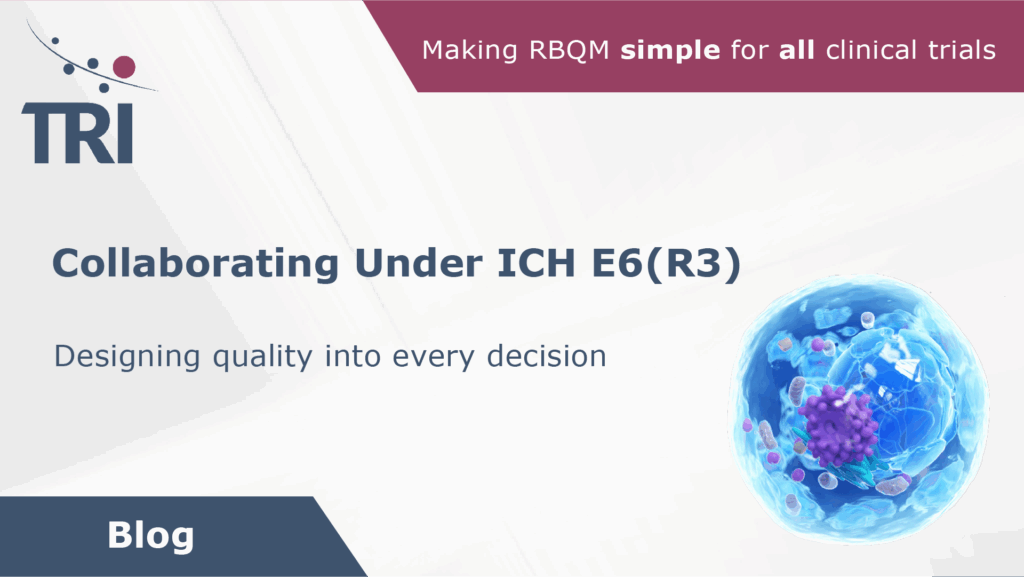Collaborating Under ICH E6 (R3)

Making Operational Alignment a Priority
There’s something different about ICH E6 (R3).
It doesn’t read like a typical regulatory update. It’s less “tighten the screws” and more about redesigning the entire machine. The tone is sharper. The expectations are higher. And the message, especially to sponsors, is unmistakable: quality can’t be something you bolt on at the end. It needs to be built into the bones of the trial. From day one. With your CRO right there with you.
This isn’t business as usual. Not even close.
Quality Has to Be Co-Owned
Annex 3.10 outlines a sponsor’s responsibility to implement a quality system that spans the entire trial lifecycle. While the concept isn’t new, the level of granularity and the expectation that quality is operational are.
Yes, the sponsor is accountable, but accountability without operational capability is just liability. If your systems and processes don’t support joint ownership of risk, quality, and decision-making with your CRO, then the responsibility written into your QMS becomes difficult to execute, and even harder to defend during inspection.
This is precisely where OPRA becomes non-negotiable when it comes to principles of risk-based quality management. OPRA enables sponsors to identify risks (3.10.1.1), evaluate them (3.10.1.2), control them (3.10.1.3), communicate them (3.10.1.4), review them (3.10.1.5), and report them (3.10.1.6), all within a single, validated platform. It transforms quality from a concept into a living, traceable operational reality.
Quality needs to be reflected in day-to-day trial operations, and that’s where many partnerships struggle. Not because the intent is lacking, but because the infrastructure to support real-time, bidirectional collaboration often isn’t there. This gap directly impacts risk assessment, a risk-based approach and how teams respond to identified risk.
OPRA is that infrastructure.
Monitoring That Moves the Needle
Monitoring has always mattered. But under E6(R3), it’s no longer about checking the box that says “we’ve looked.” It’s about what you looked at, when, why, and what you did next.
Annex 3.11 is explicit: monitoring must be ongoing, risk-adaptive, and data-driven. Centralized monitoring is now a regulatory expectation. The question is no longer should you do it? It’s can you do it well, and at scale?
OPRA directly supports Annex 3.11.4.2 by allowing sponsors and CROs to evaluate accumulated data in real time, detect protocol deviations, identify data anomalies, and act on trends before they become findings. It supports both site-level and system-level oversight, with full traceability and audit readiness. This is the foundation of effective centralized monitoring for clinical trials.
If your decisions outpace your data, or if your insights aren’t shared across sponsor and CRO teams simultaneously, then you’re already reacting too late.
That’s why systems must support fast, connected access to data collected across sponsor and CRO teams.
Why Collaboration Fails Without the Right Systems
One of the most persistent myths in clinical trials is that “good collaboration” is about frequent contact or strong relationships. Those things matter, but they’re certainly not enough.
Real collaboration shows up in the systems you design, not just the culture you promote. If your workflows rely on manual reconciliation, retrospective reporting, or handoffs between systems, then collaboration becomes reactive.
OPRA is a decision engine designed to eliminate that lag. It enables sponsor and CRO teams to act on the same data, at the same time, with full context and accountability. It supports Annex 3.10.1.4 and 3.11.4.6 by ensuring that risk communication and monitoring reports are not just documented, but actionable.
Annex 4: The Infrastructure We Pretended Was Optional
Historically, clinical trial systems have been underbuilt and over trusted. Sponsors often lean on spreadsheets, emails, or loosely integrated tools to run trials, hoping things hold together until closeout.
Annex 4 challenges that complacency. It clearly states that systems must be validated, secure, and capable of producing clean, auditable, and timely data.
If your systems can’t scale, trace, or withstand scrutiny across a multi-trial portfolio, the risk isn’t just non-compliance, it’s operational fragility. OPRA was built to prevent that fragility.
OPRA is fully validated, with robust audit trails, user authentication, role-based access, and metadata capture. It supports secure access via MFA or SSO and maintains a complete record of user activity and system changes. In short, it’s built to withstand scrutiny, whether from regulators, auditors, or your own QA team.
Why “Compliant Enough” Isn’t Enough
The sponsors that will thrive under the new guideline won’t just interpret the guidance well, they’ll operationalize it effectively. They’ll invest in systems that make risk visible, in workflows that make accountability natural, and in partnerships where both sides can act with confidence.
There’s an important distinction to draw here: compliance is the floor, not the ceiling. The real opportunity in E6 (R3) is better trial execution. Fewer blind spots. Better coordination. And the ability to act, not just explain.
That’s what effective risk assessment and management looks like, and how top performing teams stay ahead of potential issues.
What Happens If We Don’t Evolve?
If sponsors don’t adapt, trials will get messier. Oversight will be harder. And gaps will show up in the one place no one can afford them: patient safety and data integrity.
We’ve witnessed the cost of fragmented systems and siloed thinking. E6 (R3) gives us a way forward, but only if we embrace it through a robust RBQM (Risk-Based Quality Management) approach.
This is a call to design quality into the very foundation of how trials are run. Not just at the sponsor. Not just at the CRO. But together.
Where We Go From Here
If there’s one message E6 (R3) sends clearly, it’s this: accountability is shared, and systems must reflect that. The organizations that build for this, who invest in the tools, and partnerships that make it real, won’t just pass inspections. They’ll run better trials.
In this next era of research, that’s the difference that matters.
